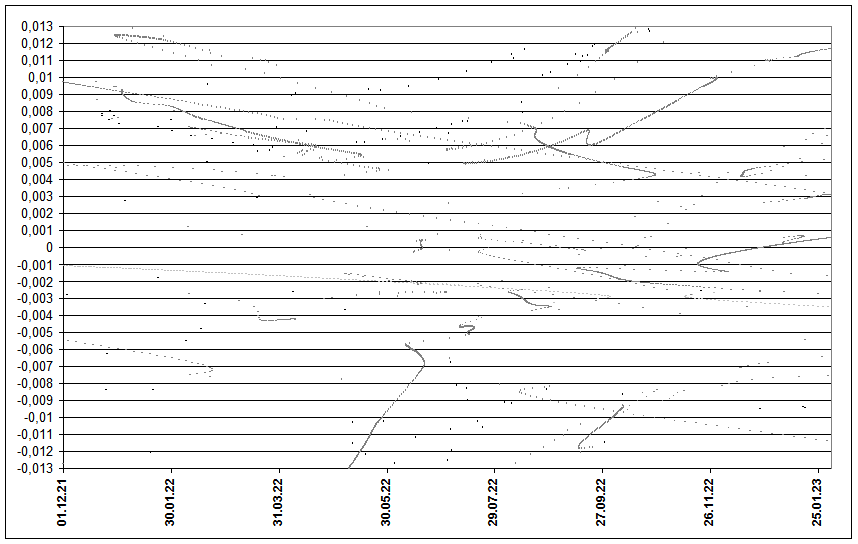Leonids 2022: prediction of activity
to the list of predictions

Fig. 1. Space-temporal projection of Leonids trails parts onto their minimal distance passages in 2022 (correspondence between colours of the particles and their ejection velocities can be seen here).

Fig. 2. Assumed profile of overall Leonid activity (blue line) and its background component (red line).

Fig. 2. Detailed view of assumed profile of overall Leonid activity (blue line) and its background component (red line).
In 2022 the Earth is expected to encounter to some trails of the comet 55P. First of all it is the encounter with 1733 trail with maximum activity expected on November 19 at 6 UT. Computed density of encountered part of the trail is high, it is 5-10 times higher than that for the regular 1 revolution Leonids trail. Missing distance to this trail is only 0.00098 AU. However the main problem for this encounter is high negative ejection velocity of particles, which is -22.9 m/s. Real saturation with particles of trail parts with so high negative ejection velocities could be several orders lower comparing to those with analogous positive ejection velocities. Therefore computed ZHR prediction for this encouter is ~600, but reliabity of this figure is very low and there is significant chance of abcence any noticable activity increase. Nevertheless this case deserves checking with observations.
The second and more modest possible activity increase could be caused by 1800 trail. But the Earth also ecounters the part of this trails composed of particles with significant negative ejection velocities of -18.6 m/s. Computed ZHR for this encounter is 10 but reliability of this prediction is also low. Computed maximum time for this trail is November 21 15:17 UT, it stays quite far from traiditional Leonids maximum, by November 21 background Leonids activity should mainly pass over making easier detection of any activity increase at that time.
References
1. "Comet's dust 2.0" program by S. Shanov and S. Dubrovsky. [Used for orbital computations.]
2. E. Lyytinen, T. van Flandern "Predicting the strength of Leonid outbursts", 2000, Earth, Moon, and Planets, P. 149-166.
3. Jenniskens P. Meteor showers and their parent comets, 2006, 780 p. 4. Kasuo Kinoshita, http://jcometobs.web.fc2.com/ [Orbital elements of the comet 55P Tempel-Tuttle]